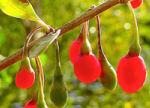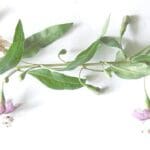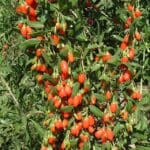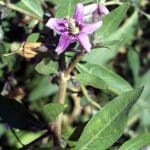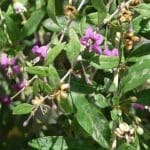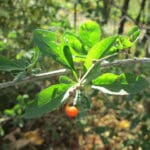Duke of Argyll’s tea tree / Spring / Summer / Autumn / Edible
Like many I’d imagine, I hadn’t heard of Goji berries (Duke of Argyll’s tea tree) until the early 2000’s when they became popular as a supposed ‘super food’. I imagined them growing on a rare, recently discovered tree in an exotic part of the world, needless to say, I was surprised to read that they’ve been grown in the UK since the 1700s and are considered naturalized.
Common Names
Duke of Argyll’s tea tree, Wolfberry, Goji Berry, Chinese wolfberry, Barbary matrimony vine, Red medlar
Botanical Name
Lycium barbarum
Scientific Classification
Kingdom – Plantae
Order – Solanales
Family – Solanaceae
Physical Characteristics for Duke of Argyll’s tea tree
Leaves
The leaves form on the shoot either in an alternating arrangement or in bundles of up to three. Each leaf is green, spearhead-shaped, sometimes with rounded tips. The clustered leaves are up to 2.5 cm long, the single alternate leaves are up to 5.5 cm long.
Flowers
The purple, trumpet-shaped flowers grow in groups of 1-3. Up to 1 cm long they have 5 long, protruding stamens.
Fruit
The berries are red to orange in colour, round to ellipsoid, and contain between 10-40 tiny seeds.
Habitat
They have been grown in the UK since the 1700s and appear in hedgerows and often they are used as hedging on coastal sites.
Known Hazards
None known with the plant itself but some of the compounds contained are known to interact with certain commercial medicines. Such drugs include warfarin and drugs for diabetes, tachycardia, or hypertension.
Could be Confused with
Care needs to be taken with this plant, as it belongs to the Solanaceae family which contains some poisonous members, including Deadly nightshade (Atropa belladonna). That said, tomatoes, potatoes, and aubergine are also members of this family.
Deadly nightshade (Atropa belladonna) has purple-black berries.
Bittersweet (Solanum dulcamara) has quite similar looking red/orange berries. It is not as poisonous as deadly nightshade, but it’s certainly not something you would want to eat. The main difference is the leaf shape. Goji has thin elongated oval-shaped leaves while bittersweet has wider oval leaves that are more distinctly pointed at the tip; they also smell like burnt rubber when you crush them. Goji also has small thorns on the stems while bittersweet does not.
Edible Uses
The berries have been marketed as a ‘super food’ since the early 2000’s and are used as a raisin replacement. The drive berries appear in granola and flapjacks very often.
The leaves and young shoots are a nice green vegetable and work well in stir fries and Asian-style soups and broths. Although they can be a little bitter.
Traditionally in the UK, the leaves were steeped in boiling water to make tea. I prefer using a mixture of fresh leaves and dried berries.
The seeds either whole or crushed, are commercially available too.
Notes on Herbal Uses
Lots of claims have been made about the medicinal qualities of the plant and research is still ongoing.
One of the most extreme claims is the story that a Chinese man named Li Qing Yuen, who was said to have consumed wolfberries daily, lived to the age of 256 years (1677–1933).
Modern research shows that they have high levels of antioxidants, vitamins A and C, and beta-carotene. Beta-carotene is vital for eye, bone, and skin health. The amount of beta-carotene in goji berries is among the highest of all edible plants.
Research on mice finds goji berries may inhibit tumour growth and boost the effectiveness of cancer treatments.
They may also be helpful for stabilising blood sugar, anxiety, and depression, as well as protecting your liver.
Extra notes from the Foragers
It’s best to harvest the berries by shaking them off the plant into a basket or tub. When the berries are handled they very often turn black, which doesn’t affect the taste but makes them look less attractive.



